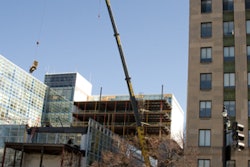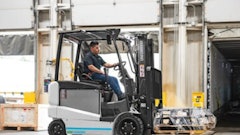It was something of a disaster. On the morning of June 20, 2007 the Shoshone hydroelectric plant in Glenwood Canyon, Colorado was crippled when one of its two large penstocks pipes ruptured, sending millions of gallons of water and debris crashing into the station and canyon floor below.
Upon inspection, estimates put repair time at two years. Excel Energy, operator of the plant, didn't have that kind of time. Facing a critical outage and requiring expedient repair, they turned to Garney Construction of Kansas City, Missouri to head up the repair operation.
Lifting or pulling: |
Lifting |
Line pull required: |
10,000 lbs |
Line speed required: |
21 fpm |
Travel distance of load: |
300 feet |
Power source: |
230/3/60 |
Installation: |
Base |
Requirements: |
Mounted |
Environment: |
Indoor/Outdoor |
Frequency of Operation: |
Intermittent |
Removal and replacement of the penstocks would be a serious undertaking and require a significant amount of time to accomplish. Garney had experience working in the extreme mountain environment working in nearby Telluride, Colorado the previous winter. Upon inspecting the site, Garney Senior Vice President Steve McCandless proposed a different, almost unbelievable solution.
"At first they gave us a funny look", recalls McCandless. "But with a little time and explanation we were able to convince them to go with our plan."
Garney's solution was unique. Rather than taking the conventional approach of completely replacing the existing penstocks, Garney planned to slide a slightly smaller set of pipes inside the existing ones, effectively creating a new set of penstocks. Most importantly it was less expensive, less intensive and safer to undertake. Excel approved Garney's proposal and work quickly began to return Shoshone station to full capacity operation.

The unique location and configuration of Shoshone station meant that replacement of the two existing penstocks feeding water to the station would be a daunting task. Both pipes - 120 inches in diameter - run parallel to each other at a 45-degree angle nearly 300 feet from the head gate down the wall of the canyon to the station.
"I knew immediately that a winch was the way to do it", says McCandless. "I didn't really know where to go to find winches that could do the job, did some searching on the Internet and found some references to winches that could. Then during that process someone sent me a winch chart that had Thern's name on the bottom. At that point I went directly to Thern."
McCandless talked with Thern's technical sales department. Going over the required job specs, they came up with a couple of options, the second facilitating variable frequency control.
"We chose the variable frequency control option, because I knew that the kind of work we would be doing would require the precision you get with this style of control", McCandless says.

They chose a model 4HS11M-11000-20-D helical-spur electric winch. A 6,000-pound load capacity was required and with 11,000-pound line pull, the 4HS11M provided more than enough pulling power. Spooled with 300 feet of 5/8-inch wire rope, the winch afforded the work crew a line speed of up to 20 per minute along with the critical control they required for pulling each new section of pipe into position. Requiring complete equipment redundancy, Garney ordered two units.
The work was anything but simple. The new pipes required installation in sections and the winches would pull them up through the existing penstocks one at a time. To begin, the crew created a larger hole at the base of the penstocks and cut away the damaged sections to enable new pipe to be fit inside.
The winches sat at the head gate above the penstocks. The winch line, fitted with four connectors, was lowered down through the existing penstocks to the station where crew connected new pipe to the line. A winch then pulled the new section back up, the largest being 10 feet long and weighing 5,000 lbs. Once in position a series of measurements were taken to ensure placement and pipe alignment were exact. Crews then made a series of precision welds to secure the pipes in place.
Each section took approximately two hours to connect to the line, pull through the penstock and weld into place. On good days Garney's crew was completing 50 feet of new pipe a day, putting them well ahead of schedule.
"We started work in November 2007 and were done in February 2008", says McCandless. "Shoshone went back online in April."
In the end, Shoshone was back online a seemingly impossible 14 months ahead of the initial two-year projection and less than a year after the accident. A complicated undertaking, innovative thinking and reliable Thern equipment made Garney's job possible.
"The job was a big success", says McCandless. "The winches worked exactly as planned, without any complications or problems."





















